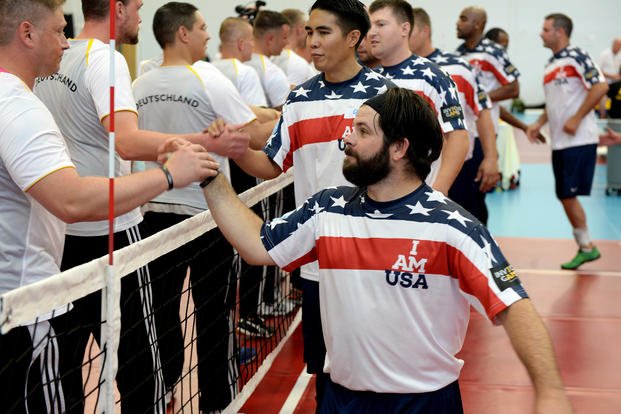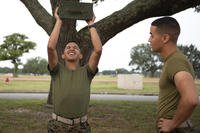This is probably one of the most important responses I've written to a question. I hope to help this disabled veteran and others with some creative ideas about fitness.
I am a disabled veteran who subscribes to Military.com, and when catching up on old issues after my vacation, I found a reference to your stretching plan for use before starting any exercise plan. I find your articles very interesting, but there is one area in particular I wish you would cover. There are a number of disabled veterans I know who subscribe to Military.com, and they might also be interested in this.
Many of us are permanently, very physically limited due to our injuries and medical conditions. In spite of this, we are still interested in keeping in shape as best we can, as well as keeping our weight in check. It is very difficult to find exercise plans that address this. Could you make a plan/article for us? Many of us are living on disability checks and don't have gyms or other facilities available or the funds to pay for expensive plans, so I think it would really be appreciated. I know I would really appreciate it.
Thank you,
Disabled Vet
No -- thank you. I have written several articles already that may help you, but this one will focus on how I have helped disabled veterans and amputees with creative fitness ideas in the past. This article will focus on a variety of ways to perform many of the exercises you used to do in the military, or at least work the same muscle groups.
You may need some special equipment like dumbbells, rubber bands, or wrist and ankle weights, but they are inexpensive and can be found in most physical therapy clinics. The following link will give you access to my free 45-Day Beginner Program (PDF) with pictures of all the stretches and exercises I discuss in this article.
For starters, here are some related articles for you to check out:
Stretching Can Do it All
First of all, the stretching plan you asked about earlier is ideal for just about anyone. The stretches can be performed standing up, on the floor or in a chair, if needed. Holding stretches for 45-60 seconds can have an isometric effect on your muscles, meaning you actually can work the muscle by stretching. The muscle contracts after nearly a minute of stretching it. That is one reason why people who do yoga look so toned. So when all else fails, do the stretching plan until you feel your muscles start to contract.
Upper-Body Exercises
Chest, triceps, biceps, abs, lower/upper back and shoulders
Push-ups
You know how to do them. But with certain injuries, working your chest, triceps and shoulders with these exercises may be challenging. For example, many people have issues with their wrists not bending properly. What I would recommend in this case is to do a push-up on a set of hexagonal dumbbells where you can place the heel of your palm on the bar without bending your wrist.
Another option is to do the push-ups on your fists. Lay a towel under your hand unless you are a hardcore martial artist who likes to toughen up the fists. There are a few alternatives.
Floor bench press
Alternative chest, triceps and shoulder workouts can be performed with wrist weights or dumbbells. While lying on the floor on your back, move like you would during a bench-press exercise. Shoot for as many as you can with the weight you select for 3-4 sets.
Rubber-band push-ups
Wrap the center of the band around your upper back, grab the end of the bands in your hands and push away from yourself, using the same motion as the push-up or bench press. You can do this sitting or lying down. Depending on the tension, do as many as you can 3-4 times.
Military press and triceps extensions
Using dumbbells, wrist weights or elastic bands, these exercises can be done sitting in a chair or standing. Raise your hands over your head and then bend your elbows so your hands are behind your head. Repeat this motion for 10-15 times for at least 3-4 sets.
See the The Best Shoulder Workout article for an even better shoulder workout that can be done with dumbbells, wrist weights or bands.
Chair dips
Lift yourself out of your chair 10-15 times for 3-4 sets. See the bench-dip picture for details. This is a functional and challenging exercise for your triceps.
Torso Exercises
Abs, lower and upper back
Depending upon the severity of your injury, you may be able to do all or some of these exercises. It is best to try these while lying down on the floor, but you can do them in a chair, if needed.
Crunches
By just lifting your shoulders off the floor, you flex your abs. Now, you also can flex your abs by lifting your hips off the floor (reverse crunch), or you can flex your abs by doing a seated crunch as well. A seated crunch requires you to bend forward a few inches and flex your stomach muscles for 10 seconds. Repeat 10 times, and you will feel this one. See the "Resting with Crunches" article for more ideas.
Try practicing rolling over on your back from your stomach 10 times without stopping, too. This is a great way to work the torso if you're having difficulty with crunches.
Lower-back exercises
Pictured in the article above is a torso balancing exercise I call Swimmers. This is done by lifting your legs off the floor while lying on your stomach. This works the lower back, rear end and hamstrings. Sitting down performing this exercise requires a stretch and flex combination. Bend forward in your chair, taking your chest to your knees, then using the muscles in your lower back, sit upright again.
Upper-back exercises
The reverse push-up, arm haulers and birds that can be found in the lower-back article listed above are great ways to lie down and work out your upper back. You also can do these with rubber bands while sitting. Place the rubber bands around a pole or something sturdy, and pull with both hands so you bring your elbows past your shoulders, flexing your upper back. This is great for the posture and balances out your shoulder and chest muscles.
Lower-body exercises
In the 45-Day Plan linked above, you will see pictures of squats, lunges and heel raises. These may be tough if you suffer from a spinal injury or an amputated limb. However, you can work your leg muscles while sitting down by doing leg extension or leg curls with ankle weights. You even can do one-legged squats if you can hold on to something for balance. See the pictures for the leg movements in the Circuit Training article. Though I am using a weight machine in this picture, try it with rubber bands or ankle weights, using the pictured motion.
I hope this article is helpful to those fellow veterans who gave so much for us. Feel free to email me if you have specific issues that did not get covered in this article. Also, if any readers have links they would like to share, please email me at stew@stewsmith.com, and I will help share information for others.
Here are some more great ideas from disabled combat vet, and now trainer, Deandre Wells:
No matter the disability, our goal is to help our vets redefine themselves and live an active, healthy lifestyle! Free for all Veteran Affairs disabled veterans. AGX, Adapted Group Fitness, is a therapeutic, adaptive, energetic and music-driven fitness experience that serves those who desire to experience an effective form of burning fat with less impact and less chance of injury. This highly addictive style of training ranges from 30-60 minutes. Our passionate instructors, high-intensity workouts and collaborative music will help increase the release of cortisol (aka the stress hormone) and eat away fat stores. All interested veterans should contact me at wells78@live.com.
Stew Smith is a former Navy SEAL and fitness author certified as a Strength and Conditioning Specialist (CSCS) with the National Strength and Conditioning Association. Visit his Fitness eBook store if you're looking to start a workout program to create a healthy lifestyle. Send your fitness questions to stew@stewsmith.com.
Want to Learn More About Military Life?
Whether you're thinking of joining the military, looking for fitness and basic training tips, or keeping up with military life and benefits, Military.com has you covered. Subscribe to Military.com to have military news, updates and resources delivered directly to your inbox.




















